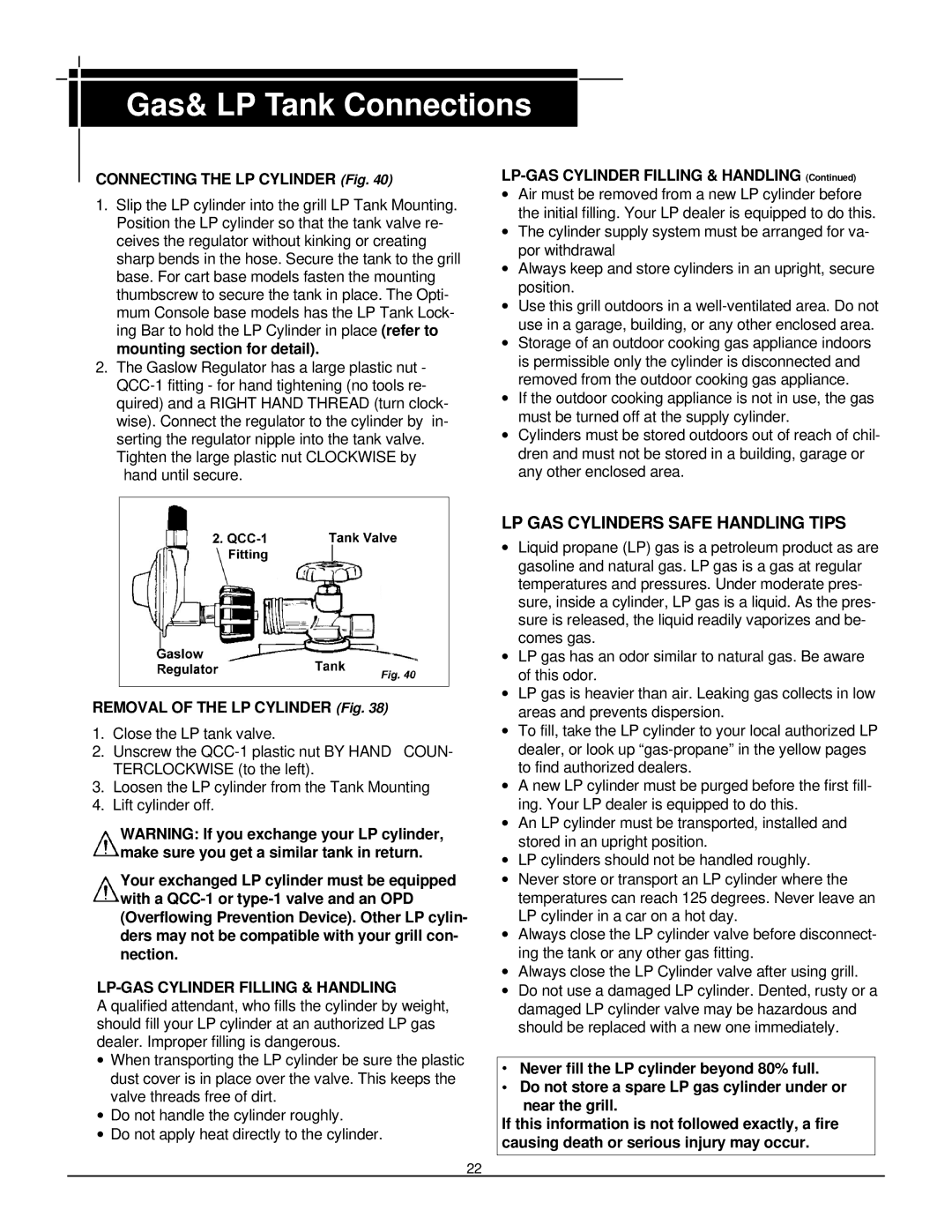
Gas& LP Tank Connections
CONNECTING THE LP CYLINDER (Fig. 40)
1.Slip the LP cylinder into the grill LP Tank Mounting. Position the LP cylinder so that the tank valve re- ceives the regulator without kinking or creating sharp bends in the hose. Secure the tank to the grill base. For cart base models fasten the mounting thumbscrew to secure the tank in place. The Opti- mum Console base models has the LP Tank Lock- ing Bar to hold the LP Cylinder in place (refer to mounting section for detail).
2.The Gaslow Regulator has a large plastic nut -
LP-GAS CYLINDER FILLING & HANDLING (Continued)
•Air must be removed from a new LP cylinder before the initial filling. Your LP dealer is equipped to do this.
•The cylinder supply system must be arranged for va- por withdrawal
•Always keep and store cylinders in an upright, secure position.
•Use this grill outdoors in a
•Storage of an outdoor cooking gas appliance indoors is permissible only the cylinder is disconnected and removed from the outdoor cooking gas appliance.
•If the outdoor cooking appliance is not in use, the gas must be turned off at the supply cylinder.
•Cylinders must be stored outdoors out of reach of chil- dren and must not be stored in a building, garage or any other enclosed area.
REMOVAL OF THE LP CYLINDER (Fig. 38)
1.Close the LP tank valve.
2.Unscrew the
3.Loosen the LP cylinder from the Tank Mounting
4.Lift cylinder off.
WARNING: If you exchange your LP cylinder, make sure you get a similar tank in return.
Your exchanged LP cylinder must be equipped with a
LP-GAS CYLINDER FILLING & HANDLING
A qualified attendant, who fills the cylinder by weight, should fill your LP cylinder at an authorized LP gas dealer. Improper filling is dangerous.
•When transporting the LP cylinder be sure the plastic dust cover is in place over the valve. This keeps the valve threads free of dirt.
•Do not handle the cylinder roughly.
•Do not apply heat directly to the cylinder.
22
LP GAS CYLINDERS SAFE HANDLING TIPS
•Liquid propane (LP) gas is a petroleum product as are gasoline and natural gas. LP gas is a gas at regular temperatures and pressures. Under moderate pres- sure, inside a cylinder, LP gas is a liquid. As the pres- sure is released, the liquid readily vaporizes and be- comes gas.
•LP gas has an odor similar to natural gas. Be aware of this odor.
•LP gas is heavier than air. Leaking gas collects in low areas and prevents dispersion.
•To fill, take the LP cylinder to your local authorized LP dealer, or look up
•A new LP cylinder must be purged before the first fill- ing. Your LP dealer is equipped to do this.
•An LP cylinder must be transported, installed and stored in an upright position.
•LP cylinders should not be handled roughly.
•Never store or transport an LP cylinder where the temperatures can reach 125 degrees. Never leave an LP cylinder in a car on a hot day.
•Always close the LP cylinder valve before disconnect- ing the tank or any other gas fitting.
•Always close the LP Cylinder valve after using grill.
•Do not use a damaged LP cylinder. Dented, rusty or a damaged LP cylinder valve may be hazardous and should be replaced with a new one immediately.
•Never fill the LP cylinder beyond 80% full.
•Do not store a spare LP gas cylinder under or near the grill.
If this information is not followed exactly, a fire causing death or serious injury may occur.
